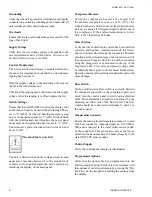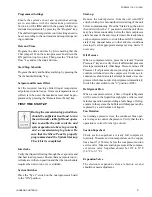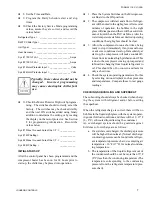
FORM 201.19-CL1 (309)
JOHNSON CONTROLS
5
SYStEm StARt-UP CHECk LISt
JOB nAmE: ______________________________
SALES ORDER #: _________________________
LOCAtIOn: _______________________________
SOLD BY: ________________________________
InStALLIng
COntRACtOR: ___________________________
StARt-UP
tECHnICIAn/
COmPAnY: _______________________________
StARt-UP DAtE : _________________________
CHILLER mODEL #: _______________________
SERIAL #: ______________________________
__
COmPRESSOR #1
mODEL#: ________________________________
SERIAL #: _______________________________
COmPRESSOR #2
mODEL#: ________________________________
SERIAL #: _______________________________
UnIt CHECkS (nO POwER)
Check the system 24 hours prior to initial start.
1. Inspect the unit for shipping or installation
damage.
2. Assure that all piping has been completed.
3. Check that the unit is properly charged and that
there are no piping leaks.
4. Open each compressor suction service
valve, discharge service valve, economizer
service valve, liquid line stop valve, and oil
line ball valves.
5. The compressor oil level should be maintained
so that an oil level is visible in either of the two
oil separator sight glasses. In other words, oil
level should always be maintained, running or
not, above the bottom of the lower sight glass
and below the top of the upper sight glass.
If it is necessary to add oil, connect a YORK oil
pump to the charging valve on the oil separator,
but do not tighten the flare nut on the delivery
tubing. With the bottom (suction end) of the
pump submerged in oil to avoid entrance of air,
operate the pump until oil drips from the flare nut
joint, allowing the air to be expelled, and tighten
the flare nut. Open the oil charging valve on the
oil separator and pump in oil until it reaches the
proper level as described above.
In actual operation, due to splashing,
an oil level may be seen in both sight
glasses. Run the compressor for a few
minutes fully loaded, shut the system
down, and assure there is an oil level
showing in the bottom or top sight
glass with the compressor “OFF”.
6. Assure water pumps are on. Check and adjust
water pump flow rate and pressure drop across
the evaporator.
Excessive flow may cause catastrophic
damage to the evaporator.
7. Check the control panel to assure it is free of
foreign material (wires, metal chips, etc.).
8. Visually inspect wiring (power and control).
Wiring MUST meet N.E.C. and local codes.
9. Check tightness of power wiring inside the power
panel on both sides of the motor contactors and
inside the motor terminal boxes.
10. Check for proper size fuses in main and control
circuits.
11.Verify that field wiring matches the 3‑phase
power requirements of the compressor. See
chiller nameplate.
12. Assure 115VAC Control Power has 30A mini-
mum capacity.
13. Be certain all water temp sensors are inserted
completely in their respective wells and are
coated with heat conductive compound.
14.Assure that evaporator EEV bulbs are strapped
onto the suction lines at 4 or 8 o’clock posi-
tions.
15. Assure that the 15 ton economizer TXV
bulbs are strapped onto the compressor
economizer supply lines at 4 or 8 o’clock posi-
tions.









